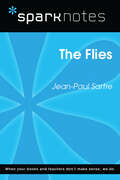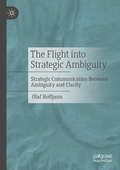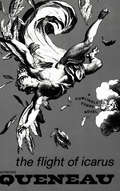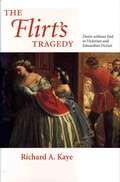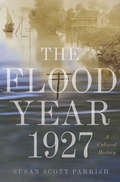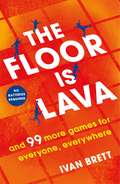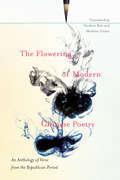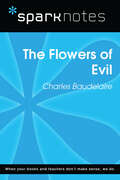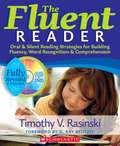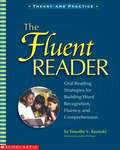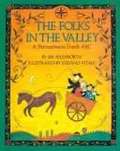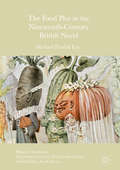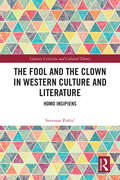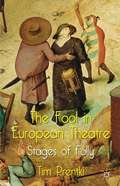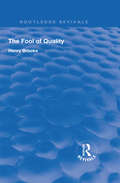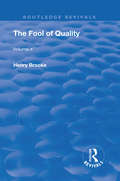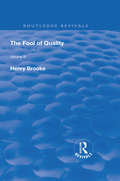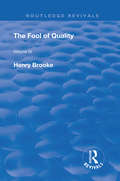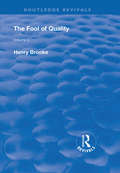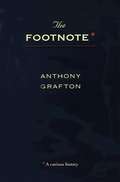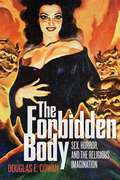- Table View
- List View
The Flies (SparkNotes Literature Guide Series)
by SparkNotesThe Flies (SparkNotes Literature Guide) by Jean-Paul Sartre Making the reading experience fun! Created by Harvard students for students everywhere, SparkNotes is a new breed of study guide: smarter, better, faster.Geared to what today's students need to know, SparkNotes provides:chapter-by-chapter analysis explanations of key themes, motifs, and symbols a review quiz and essay topics Lively and accessible, these guides are perfect for late-night studying and writing papers.
The Flight into Strategic Ambiguity: Strategic Communication Between Ambiguity and Clarity
by Olaf HoffjannThis book analyses how and why advertising, PR, and corporate and political communication make use of strategic ambiguity. This special quality of vagueness allows companies to talk about the relevance of ESG or governments to promise stability and prosperity without fully committing themselves, disappointing no one and securing every freedom. This book describes in detail the diverse practices of ambiguous strategic communication – and its opposite, strategic clarity – with many examples. For academics, it offers a detailed framework for describing and researching strategic ambiguity. For PR practitioners, it provides a toolbox for the use of strategic ambiguity. Lastly, it provides journalists with a means of recognizing and criticizing questionable strategic ambiguity. This book is a translation of the original German edition “Die Flucht in die Ambiguität”. The translation was done with the help of an artificial intelligence machine translation tool. A subsequent human revision was done primarily in terms of content, so that the book will read stylistically differently from a conventional translation.
The Flight of Icarus: Novel
by Raymond QueneauThe Flight of Icarus (Le Vol d'lcare) is his only novel written in the form of a play: seventy-four short scenes, complete with stage directions. Called by some the French Borges, by others the creator of le nouveau roman a generation ahead of its time, Raymond Queneau's work in fiction continues to defy strict categorization. The Flight of Icarus (Le Vol d'lcare) is his only novel written in the form of a play: seventy-four short scenes, complete with stage directions. Consciously parodying Pirandello and Robbe-Grillet, it begins with a novelist's discovery that his principal character, Icarus by name, has vanished. This, in turn, sets off a rash of other such disappearances. Before long, a number of desperate authors are found in search of their fugitive characters, who wander through the Paris of the 1890s, occasionally meeting one another, and even straying into new novels. Icarus himself--perhaps following the destiny his name suggests--develops a passion for horseless carriages, kites, and machines that fly. And throughout the almost vaudevillian turns of the plot, we are aware, as always, of Queneau's evident delight at holding the thin line between farce and philosophy.
The Flight of the Mind: Virginia Woolf's Art and Manic-Depressive Illness
by Thomas C. CaramagnoIn this major new book on Virginia Woolf, Caramagno contends psychobiography has much to gain from a closer engagement with science. Literary studies of Woolf's life have been written almost exclusively from a psychoanalytic perspective. They portray Woolf as a victim of the Freudian "family romance," reducing her art to a neurotic evasion of a traumatic childhood.But current knowledge about manic-depressive illness—its genetic transmission, its biochemistry, and its effect on brain function—reveals a new relationship between Woolf's art and her illness. Caramagno demonstrates how Woolf used her illness intelligently and creatively in her theories of fiction, of mental functioning, and of self structure. Her novels dramatize her struggle to imagine and master psychic fragmentation. They helped her restore form and value to her own sense of self and lead her readers to an enriched appreciation of the complexity of human consciousness.
The Flirt's Tragedy: Desire without End in Victorian and Edwardian Fiction
by Richard A. KayeIn the flirtation plots of novels by Jane Austen, Charlotte Brontë, and W. M. Thackeray, heroines learn sociability through competition with naughty coquette-doubles. In the writing of George Eliot and Thomas Hardy, flirting harbors potentially tragic consequences, a perilous game then adapted by male flirts in the novels of Oscar Wilde and Henry James. In revising Gustave Flaubert's Sentimental Education in The Age of Innocence, Edith Wharton critiques the nineteenth-century European novel as morbidly obsessed with deferred desires. Finally, in works by D. H. Lawrence and E. M. Forster, flirtation comes to reshape the modernist representation of homoerotic relations.In The Flirt's Tragedy: Desire without End in Victorian and Edwardian Fiction, Richard Kaye makes a case for flirtation as a unique, neglected species of eros that finds its deepest, most elaborately sustained fulfillment in the nineteenth-century and early twentieth-century novel. The author examines flirtation in major British, French, and American texts to demonstrate how the changing aesthetic of such fiction fastened on flirtatious desire as a paramount subject for distinctly novelistic inquiry. The novel, he argues, accentuated questions of ambiguity and ambivalence on which an erotics of deliberate imprecision thrived. But the impact of flirtation was not only formal. Kaye views coquetry as an arena of freedom built on a dialectic of simultaneous consent and refusal, as well as an expression of "managed desire," a risky display of female power, and a cagey avenue for the expression of dissident sexualities. Through coquetry, novelists offered their response to important scientific and social changes and to the rise of the metropolis as a realm of increasingly transient amorous relations.Challenging current trends in gender, post-gender, and queer-theory criticism, and considering texts as diverse as Darwin's The Descent of Man and Gilbert and Sullivan's The Mikado, Kaye insists that critical appraisals of Victorian and Edwardian fiction must move beyond existing paradigms defining considerations of flirtation in the novel. The Flirt's Tragedy offers a lively, revisionary, often startling assessment of nineteenth-century fiction that will alter our understanding of the history of the novel.
The Flood Year 1927: A Cultural History
by Susan Scott ParrishThe Great Mississippi Flood of 1927, which covered nearly thirty thousand square miles across seven states, was the most destructive river flood in U.S. history. Due to the speed of new media and the slow progress of the flood, this was the first environmental disaster to be experienced on a mass scale. As it moved from north to south down an environmentally and technologically altered valley, inundating plantations and displacing more than half a million people, the flood provoked an intense and lasting cultural response. The Flood Year 1927 draws from newspapers, radio broadcasts, political cartoons, vaudeville, blues songs, poetry, and fiction to show how this event took on public meanings.Americans at first seemed united in what Herbert Hoover called a “great relief machine,” but deep rifts soon arose. Southerners, pointing to faulty federal levee design, decried the attack of Yankee water. The condition of African American evacuees in “concentration camps” prompted pundits like W.E.B. Du Bois and Ida B. Wells to warn of the return of slavery to Dixie. And environmentalists like Gifford Pinchot called the flood “the most colossal blunder in civilized history.” Susan Scott Parrish examines how these and other key figures—from entertainers Will Rogers, Miller & Lyles, and Bessie Smith to authors Sterling Brown, William Faulkner, and Richard Wright—shaped public awareness and collective memory of the event.The crises of this period that usually dominate historical accounts are war and financial collapse, but The Flood Year 1927 enables us to assess how mediated environmental disasters became central to modern consciousness.
The Floor is Lava: and 99 more screen-free games for all the family to play
by Ivan Brett'A brilliant book of 100 games you can play anywhere in your house or garden.' The Sun Playing games can be so enjoyable but don't you often find yourself playing the same old games time and time again? Well, why not let Ivan Brett inspire you with over 99 games to entertain any gathering of friends or family? Inside The Floor is Lava you'll find 100 games to satisfy any busy family and most require no equipment other than pencil and paper. There's everything from fiendish brain teasers and number puzzles to witty wordplays and physical challenges. You'll find something for everyone to enjoy and avoid the whole family resorting to screen-time! In short, this is a how-to for turning time together into quality time together. It's time to put down your screens and pick up the fun! You'll find games for every occasion: * occupy the kids on rainy days* have after-dinner fun around the table * liven up a party * cool off in the summer holidays* beat boredom in the car So what are you waiting for? Jump up and get started - the floor is lava Ivan's next book Bored? Games! 101 games to make every day more playful is out in June. You can PRE-ORDER NOW!
The Floor is Lava: and 99 more screen-free games for all the family to play
by Ivan Brett'A brilliant book of 100 games you can play anywhere in your house or garden.' The Sun Playing games can be so enjoyable but don't you often find yourself playing the same old games time and time again? Well, why not let Ivan Brett inspire you with over 99 games to entertain any gathering of friends or family? Inside The Floor is Lava you'll find 100 games to satisfy any busy family and most require no equipment other than pencil and paper. There's everything from fiendish brain teasers and number puzzles to witty wordplays and physical challenges. You'll find something for everyone to enjoy and avoid the whole family resorting to screen-time! In short, this is a how-to for turning time together into quality time together. It's time to put down your screens and pick up the fun! You'll find games for every occasion: * occupy the kids on rainy days* have after-dinner fun around the table * liven up a party * cool off in the summer holidays* beat boredom in the car So what are you waiting for? Jump up and get started - the floor is lava Ivan's next book Bored? Games! 101 games to make every day more playful is out in June. You can PRE-ORDER NOW!
The Flower Alphabet Book (Jerry Pallotta's Alphabet Books)
by Jerry PallottaRoses are red,Violets are blue...And they're only two of the flowers in this book of bright colors and delightful information. Young readers will be fascinated to find out what flower can be used to make a doll, which flower flavors tea, and which flower farmers feed to chickens.Author Jerry Pallotta and illustrator Leslie Evans have collaborated to produce a stunning bouquet of words and pictures about the world of flowers–one of nature's most beautiful gifts.
The Flowering of Modern Chinese Poetry: An Anthology of Verse from the Republican Period
by Herbert Batt Sheldon ZitnerThe May Fourth Movement launched an era of turmoil and transformation in China, as Western ideas and education encroached on the Confucian traditions at the root of Chinese society. The Republican period (1919–49) witnessed an outpouring of poetry in a form and style new to China, written in the common people’s language, baihua ("plain speech"). The New Poetry broke with the centuries-old tradition of classical poetry and its intricate forms, and the rise of China’s modern poetry reflects the rise of modern China. The Flowering of Modern Chinese Poetry presents English translations of over 250 poems by fifty poets, including a rich selection of poetry by women writers, to provide a nuanced picture of the rapid development of vernacular verse in China from its emergence during the May Fourth Movement, through the years of the Japanese invasion, to the Communist victory in the Civil War in 1949. Michel Hockx introduces the historical and literary contexts of the various schools of vernacular poetry that developed throughout the period – the pioneers, formalists, symbolists, "peasants and soldiers" poets, and Shanghai poets of the late 1940s. Each selection of verse begins with a biographical sketch of the author’s life and literary career, including their roles in the Civil War and Japanese occupation. Introducing English readers to master poets who are virtually unknown to Western audiences, this anthology presents a collection of verse written in an age of struggle that attests to the courage, sensitivity, and imagination of the Chinese people.
The Flowers of Evil (SparkNotes Literature Guide Series)
by SparkNotesThe Flowers of Evil (SparkNotes Literature Guide) by Charles Baudelaire Making the reading experience fun! Created by Harvard students for students everywhere, SparkNotes is a new breed of study guide: smarter, better, faster.Geared to what today's students need to know, SparkNotes provides:chapter-by-chapter analysis explanations of key themes, motifs, and symbols a review quiz and essay topics Lively and accessible, these guides are perfect for late-night studying and writing papers.
The Fluent Reader 2nd Ed
by Timothy V. RasinskiTim Rasinski's groundbreaking book has been updated to include coverage of the latest research on fluency, teaching strategies based on that research, new classroom vignettes, and suggestions for using a variety of texts to teach fluency such as poetry, speeches, and monologues and dialogues. You'll also find background information, assessment tools, step-by-step lessons, and teaching tips--plus video clips showing the strategies in action. For use with Grades 1-8.
The Fluent Reader: Oral Reading Strategies for Building Word Recognition, Fluency, and Comprehension
by Timothy V. RasinskiThis book will make you smile with its brilliant explanations of how to teach students to read.
The Folks in the Valley: A Pennsylvania Dutch ABC
by Jim AylesworthA rhyming alphabet book about the people and activities of a Pennsylvania Dutch settlement in a rural valley.
The Food Plot in the Nineteenth-Century British Novel
by Michael Parrish LeeThis book is about food, eating, and appetite in the nineteenth-century British novel. While much novel criticism has focused on the marriage plot, this book revises the history and theory of the novel, uncovering the "food plot" against which the marriage plot and modern subjectivity take shape. With the emergence of Malthusian population theory and its unsettling links between sexuality and the food supply, the British novel became animated by the tension between the marriage plot and the food plot. Charting the shifting relationship between these plots, from Jane Austen's polite meals to Bram Stoker's bloodthirsty vampires, this book sheds new light on some of the best-know works of nineteenth-century literature and pushes forward understandings of narrative, literary character, biopolitics, and the novel as a form. From Austen to Zombies, Michael Parrish Lee explores how the food plot conflicts with the marriage plot in nineteenth-century literature and beyond, and how appetite keeps rising up against taste and intellect. Lee's book will be of interest to Victorianists, genre theorists, Food Studies, and theorists of bare life and biopolitics. - Regenia Gagnier, Professor of English, University of Exeter In The Food Plot Michael Lee engages recent and classic scholarship and brings fresh and provocative readings to well worked literary critical ground. Drawing upon narrative theory, character study, theories of sexuality, and political economy, Professor Lee develops a refreshing and satisfyingly deep new reading of canonical novels as he develops the concept of the food plot. The Food Plot should be of interest to specialists in the novel and food studies, as well as students and general readers. - Professor April Bullock, California State University, Fullerton, USA
The Fool and the Clown in Western Culture and Literature: Homo Insipiens (Literary Criticism and Cultural Theory)
by Svetozar PoštićThe Fool and the Clown in Western Culture and Literature: Homo Insipiens is a fascinating description of these two perennial figures in European and North American history, folklore, theater, literature, arts, and popular culture. The first part of the book separates them into ten different subcategories and recounts the most vivid and influential manifestations of different kinds of fools and clowns in cultural history. The second part singles out three European writers who have made a significant contribution to the elucidation of the concept of folly. William Shakespeare, Fyodor Dostoevsky, and Samuel Beckett have painted an entire gallery of fools, clowns, and buffoons, created not only to entertain but also to explore the meaning of human life. The most important concepts in the book are illustrated by captivating characters and tales that have made people both laugh and arrive at a deeper understanding of themselves and the world around them.
The Fool in European Theatre
by Tim PrentkiWhy is folly essential to the functioning of a healthy society? Why is theatre a natural home for madness? The answers take the reader on a journey embracing Shakespeare and Jonson, Brecht and Beckett, B#65533;chner and Boal. From Falstaff to Fo via Figaro, this study examines the art of telling truth to power and surviving long enough to have a laugh.
The Fool of Quality: Volume 1 (Routledge Revivals)
by Henry BrookeFirst published in 1906, The Fool of Quality; a picaresque and sentimental novel by the Irish writer Henry Brooke, is the only one of his works which has enjoyed any great reputation. The somewhat shapeless plot is an account of the doings of young Harry Clinton, who, rejected by his decadent and aristocratic father, is educated on enlightened principles by his philanthropic uncle. Thus equipped to fight the evils of the world the innocent yet wise hero does his best to better the lot of the unfortunate Hammel Clement and his family, and other deserving cases, in the intervals between the author's frequent philosophical digressions and commentaries on the action. It is the first of five volumes.
The Fool of Quality: Volume 2 (Routledge Revivals)
by Henry BrookeFirst published in 1906, The Fool of Quality; a picaresque and sentimental novel by the Irish writer Henry Brooke, is the only one of his works which has enjoyed any great reputation. The somewhat shapeless plot is an account of the doings of young Harry Clinton, who, rejected by his decadent and aristocratic father, is educated on enlightened principles by his philanthropic uncle. Thus equipped to fight the evils of the world the innocent yet wise hero does his best to better the lot of the unfortunate Hammel Clement and his family, and other deserving cases, in the intervals between the author's frequent philosophical digressions and commentaries on the action. This book is the second of five volumes.
The Fool of Quality: Volume 3 (Routledge Revivals)
by Henry BrookeFirst published in 1906, The Fool of Quality; a picaresque and sentimental novel by the Irish writer Henry Brooke, is the only one of his works which has enjoyed any great reputation. The somewhat shapeless plot is an account of the doings of young Harry Clinton, who, rejected by his decadent and aristocratic father, is educated on enlightened principles by his philanthropic uncle. Thus equipped to fight the evils of the world the innocent yet wise hero does his best to better the lot of the unfortunate Hammel Clement and his family, and other deserving cases, in the intervals between the author's frequent philosophical digressions and commentaries on the action. This book is the third of five volumes.
The Fool of Quality: Volume 4 (Routledge Revivals)
by Henry BrookeFirst published in 1906, The Fool of Quality; a picaresque and sentimental novel by the Irish writer Henry Brooke, is the only one of his works which has enjoyed any great reputation. The somewhat shapeless plot is an account of the doings of young Harry Clinton, who, rejected by his decadent and aristocratic father, is educated on enlightened principles by his philanthropic uncle. Thus equipped to fight the evils of the world the innocent yet wise hero does his best to better the lot of the unfortunate Hammel Clement and his family, and other deserving cases, in the intervals between the author's frequent philosophical digressions and commentaries on the action. This book is the fourth of five volumes.
The Fool of Quality: Volume 5 (Routledge Revivals)
by Henry BrookeFirst published in 1906, The Fool of Quality; a picaresque and sentimental novel by the Irish writer Henry Brooke, is the only one of his works which has enjoyed any great reputation. The somewhat shapeless plot is an account of the doings of young Harry Clinton, who, rejected by his decadent and aristocratic father, is educated on enlightened principles by his philanthropic uncle. Thus equipped to fight the evils of the world the innocent yet wise hero does his best to better the lot of the unfortunate Hammel Clement and his family, and other deserving cases, in the intervals between the author's frequent philosophical digressions and commentaries on the action. This book is the fifth of five volumes.
The Footnote: A Curious History
by Anthony GraftonThe weapon of pedants, the scourge of undergraduates, the bête noire of the âeoenewâe liberated scholar: the lowly footnote, long the refuge of the minor and the marginal, emerges in this book as a singular resource, with a surprising history that says volumes about the evolution of modern scholarship. In Anthony Graftonâe(tm)s engrossing account, footnotes to history give way to footnotes as history, recounting in their subtle way the curious story of the progress of knowledge in written form. Grafton treats the development of the footnoteâe"the one form of proof normally supplied by historians in support of their assertionsâe"as writers on science have long treated the development of laboratory equipment, statistical arguments, and reports on experiments: as a complex story, rich in human interest, that sheds light on the status of history as art, as science, and as an institution. The book starts in the Berlin of the brilliant nineteenth-century historian Leopold von Ranke, who is often credited with inventing documented history in its modern form. Casting back to antiquity and forward to the twentieth century, Graftonâe(tm)s investigation exposes Rankeâe(tm)s position as a far more ambiguous one and offers us a rich vision of the true origins and gradual triumph of the footnote. Among the protagonists of this story are Athanasius Kircher, who built numerous documents into his spectacularly speculative treatises on ancient Egypt and China; Pierre Bayle, who made the footnote a powerful tool in philosophical and historical polemics; and Edward Gibbon, who transformed it into a high form of literary artistry. Proceeding with the spirit of an intellectual mystery and peppered with intriguing and revealing remarks by those who âeoemadeâe this history, The Footnote brings what is so often relegated to afterthought and marginalia to its rightful place in the center of the literary life of the mind.
The Forbidden Body: Sex, Horror, and the Religious Imagination
by Douglas E. CowanFrom creature features to indie horror flicks, find out what happens when sex, horror, and the religious imagination come togetherThroughout history, religion has attempted to control nothing so much as our bodies: what they are and what they mean; what we do with them, with whom, and under what circumstances; how they may be displayed—or, more commonly, how they must be hidden. Yet, we remain fascinated, obsessed even, by bodies that have left, or been forced out of, their “proper” place. The Forbidden Body examines how horror culture treats these bodies, exploring the dark spaces where sex and the sexual body come together with religious belief and tales of terror.Taking a broad approach not limited to horror cinema or popular fiction, but embracing also literary horror, weird fiction, graphic storytelling, visual arts, and participative culture, Douglas E. Cowan explores how fears of bodies that are tainted, impure, or sexually deviant are made visible and reinforced through popular horror tropes. The volume challenges the reader to move beyond preconceived notions of religion in order to decipher the “religious imagination” at play in the scary stories we tell over and over again. Cowan argues that stories of religious bodies “out of place” are so compelling because they force us to consider questions that religious belief cannot comfortably answer: Who are we? Where do we come from? Why do we suffer? And above all, do we matter? As illuminating as it is unsettling, The Forbidden Body offers a fascinating look at how and why we imagine bodies in all the wrong places.
